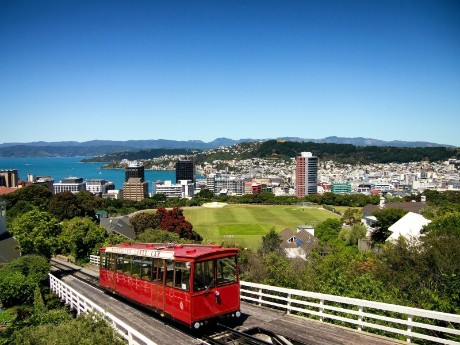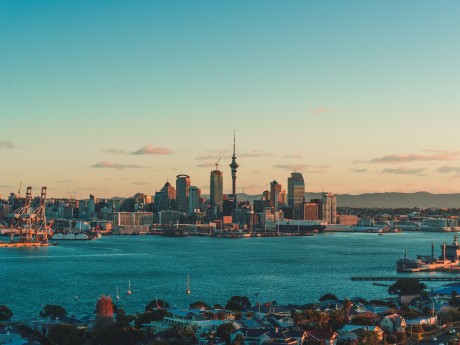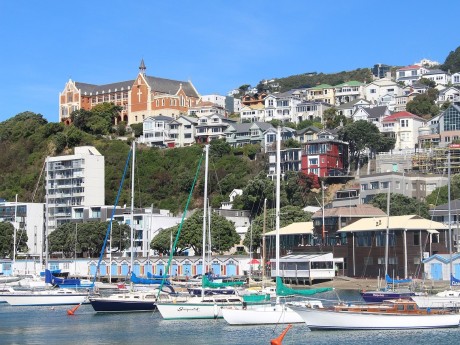New Zealand North Island: Wellington & Auckland
Embark on an enthralling journey through the captivating landscapes of Northern New Zealand, where a symphony of history, culture, and natural wonders awaits your exploration. Begin in the lively city of Wellington, a vibrant hub that opens doors to tales of antiquity. As you wander along the shores of Oriental Bay, the scenery paints a vivid picture of tranquillity, inviting you to immerse yourself in the beauty that surrounds you.
Read more
Embark on an enthralling journey through the captivating landscapes of Northern New Zealand, where a symphony of history, culture, and natural wonders awaits your exploration. Begin in the lively city of Wellington, a vibrant hub that opens doors to tales of antiquity. As you wander along the shores of Oriental Bay, the scenery paints a vivid picture of tranquillity, inviting you to immerse yourself in the beauty that surrounds you. Delve into the heart of culinary delights in charming Martinborough and Wairarapa, where every dish and sip tells a story of the land and its people. Continuing your adventure, ascend to the cosmopolitan haven of Auckland, a city that effortlessly merges the urban buzz with the soothing rhythms of the water. Revel in the unique energy that resonates through its streets and waterfront, creating an atmosphere that's both invigorating and soothing. Your journey takes a subterranean turn as you venture into the legendary Waitomo Glowworm caves, a realm of otherworldly beauty illuminated by the enchanting bioluminescence of these tiny creatures. Waterviews strives to offer accommodation options within walking distance of water and/or in an area of touristic interest. Our prices include taxes (but excludes local tourist taxes). Customize your trip to your personal preferences with optional activities (hit the “Add Activities’’) or change hotels, etc. Contact us for customization at no extra cost at: Service@waterviewstravel.com
Destinations
- Wellington
- Auckland
Itinerary
Wellington

Surrounded by hills and a quaint harbour and with steep, winding streets and Victorian era architecture, New Zealand’s buzzing capital has something to offer for everyone. Home to a unique craft beer and coffee culture, as well as a vibrant arts and nightlife scene, the city hosts various festivals in addition to its many theatres, galleries and museums. Be sure to visit the renowned Te Papa museum and admire the city’s colourful rooftops from Mount Victoria before sampling one of Wellington’s excellent restaurants and bars.
Read more
Surrounded by hills and a quaint harbour and with steep, winding streets and Victorian era architecture, New Zealand’s buzzing capital has something to offer for everyone. Home to a unique craft beer and coffee culture, as well as a vibrant arts and nightlife scene, the city hosts various festivals in addition to its many theatres, galleries and museums. Be sure to visit the renowned Te Papa museum and admire the city’s colourful rooftops from Mount Victoria before sampling one of Wellington’s excellent restaurants and bars.
Additional Information
Wellington is home to 412,500 people, making it New Zealand's second-largest urban area, well behind Auckland and just ahead of Christchurch. Wellington became New Zealand's capital city in 1865, replacing Auckland; the government wanted a more centrally-located city as capital to quell the South Island nationalist movement.
Wellington offers a blend of culture, heritage, fine food and coffee, together with lively arts and entertainment.
Surrounded by hills and a rugged coastline, the city has a stunning harbour. Wellington’s charm is that it serves up a vibrant inner city experience with a slice of New Zealand scenery. And because of its compact nature, you can sample it all: boutiques, art galleries, trendy cafés and restaurants. Right on its doorstep is a network of walking and biking trails with beautiful wineries and vineyards just a few hours away.
Wellington offers an array of theatre, music, dance, fine arts and galleries and museums. It is also home to one of the nation’s key attractions, the Museum of New Zealand Te Papa Tongarewa.
The city promotes itself as "Absolutely Positively Wellington". Its motto Suprema a situ claims site supremacy, with some justification.
Geology
Much of the central city is built on land that was raised up after a major earthquake in 1855. More land has been reclaimed since then. The shoreline as it was in 1840 is marked by plaques in the footpaths on Lambton Quay (hence the street name). There are several "quays" which are now nowhere near the harbour. The harbour's former name was 'Port Nicholson' and the smaller bay surrounded by the city is called 'Wellington' or 'Lambton Harbour'.
Earthquakes have played a major part in forming the whole Wellington region. Several earthquake fault lines run through the Wellington region, including the Wellington Fault, which runs west of the city centre along Glenmore Street and Tinakori Road to the Aotea Quay motorway interchange and then up the western Hutt Valley. Building regulations have meant that many older city buildings have been either demolished or strengthened, or require such work to be undertaken. Small and moderate earthquakes occasionally rock Wellington; so if the earth seems to move for you, it may not be just your imagination. Stay indoors until a "warden" or similar authority advises evacuation (unless you are in imminent danger, e.g. from a fire), and take shelter from potentially falling objects wherever you are.
There are some places in Wellington where damage from the 1855 earthquake is still visible. The most accessible is a large landslip on State Highway 2 between Ngauranga and Korokoro (just north of Rocky Point where the BP petrol station is located) where the dramatic change in terrain is visible. Bush has overgrown the slip but it is visible. However, most people are oblivious to the location of landslip as they drive by on the highway.
Climate
The city is known as "Windy Wellington" - often said to be the world's windiest city, with an average wind speed of 27km/h. The prevailing wind is from the northwest but the strongest winds are southerly. The wind speed and direction can be seen by the flag being flown from the Beehive; a large flag is flown only on calm days, a small flag is flown when windy days are expected. The highest wind speed ever recorded in Wellington was 275 km/h (170 mph) during the Wahine storm of 10 April 1968 (so called because it blew the interisland steamer ferry Wahine into the reef at the entrance of Wellington Harbour, causing her to founder and claim 53 lives.)
The temperature in Wellington rarely drops to 0°C (32°F), even on cold winter nights, while daytime winter temperatures are rarely lower than 8°C (46°F). During summer, the daytime maximum temperature rarely gets above 25°C (77°F). Away from the seaside, in inland valleys, frosts of up to -10°C (14°F) have been recorded. Snow falls on the nearby ranges during winter, but is rare in the urban area.
Geography
Wellington sits at the southern tip of New Zealand's North Island. The city core lies along the western shore of highly protected Wellington Harbour, with the city's suburbs spreading out in all directions. The city's primary urban core consists of the CBD and the adjoining 'city suburb' of Te Aro, to the south and east. A fairly dense zone continues south from Te Aro into the adjoining suburbs of Mt Cook and Newtown, as well as Kilbirnie on the other side of the parklands of Mt Victoria.
East from Te Aro, north-south-running ridgelines form Mt. Victoria and, further east yet, the Miramar Peninsula, which forms the western side of the mouth to Wellington Harbour. These hills—and the isthmus between—are home to a number of suburban areas as well as parkland and beaches.
Several kilometres south of central Wellington is the rugged and stunning South Coast of the North Island, consisting of a string of small (and some large) bays, many with rocky beaches and interesting tide pools.
To the west, the suburbs between Karori and Johnsonville spread into the hillsides, with various parks and hiking trails, and then give way to open rural areas such as Makara.
Holidays
Aside from the national public holidays, Wellington has its own public holiday, Wellington Anniversary Day. Commemorating the arrival of Wellington's first European settlers aboard the Aurora on 22 January 1840, it is observed across most of the Greater Wellington and Manawatu-Wanganui region on the Monday closest to 22 January.
© Sourced from Wikivoyage
Auckland

Set between two natural harbours and within a one hour drive from rugged beaches, rainforest and wildlife reserves, Auckland is perfect for those looking to relax yet enjoy the buzzing atmosphere of a big city. Rated as one of the world’s top cities for quality of life, Auckland is a modern hub and offers a warm climate. Visit the the impressive Art Gallery and Auckland Museum to learn about New Zealand’s culture and Maori heritage, before meandering in the city’s multicultural market of Otara or taking a hike up impressive volcanic Mount Eden.
Read more
Set between two natural harbours and within a one hour drive from rugged beaches, rainforest and wildlife reserves, Auckland is perfect for those looking to relax yet enjoy the buzzing atmosphere of a big city. Rated as one of the world’s top cities for quality of life, Auckland is a modern hub and offers a warm climate. Visit the the impressive Art Gallery and Auckland Museum to learn about New Zealand’s culture and Maori heritage, before meandering in the city’s multicultural market of Otara or taking a hike up impressive volcanic Mount Eden.
Additional Information
Auckland is New Zealand's largest city, home to 1.49 million people, nearly one-third of the country's population and more than the entire South Island. It is the main economic and travel hub, home to an international airport. It's lucky enough to have its own beautiful landscapes, waterways, and other attractions to draw tourists in. It is not New Zealand's political capital though – that honour goes to Wellington.
Auckland is called the "City of Sails" for the large number of yachts that grace the Waitemata Harbour and the Hauraki Gulf, and for the city's love of sailing. More than 135,000 yachts and launches are registered in Auckland and several America's Cup regattas have been held here. Auckland could also be called the "City of Volcanoes". Much of its natural character comes from the fact that it is built on the Auckland Volcanic Field which consists of about 50 volcanoes. All of the volcanoes are individually extinct (Rangitoto was the latest to erupt, in the mid to late 15th century) but the volcanic field as a whole is not. The city also features a large number of urban beaches and parks, numerous arts and cultural institutions and events, and is home to a multitude of sporting teams.
Auckland is frequently ranked highly in international quality-of-life polls, including third in Mercer's Quality of Living Ranking (behind Vienna and Zurich). However, Auckland is also New Zealand's most expensive city – house prices alone are double to triple those found in Wellington, Christchurch and Hamilton (the latter just 130 km down the road from Auckland).
Auckland is very multicultural, with strong immigrant cultures. Some 40 percent of Auckland's population was born overseas; in two local board areas, Puketapapa (Mount Roskill) and Howick, there are more overseas-born residents than New Zealand-born ones. It has the largest Polynesian population of any city in the world. For some Polynesian island nations, there are more expatriates living in Auckland than in their homeland. There is also a large population of New Zealand's native Maori people, and populations of immigrants and expats from the UK, China, India, South Africa, South Korea and the Philippines, among others. Auckland's rich cultural mix is celebrated with a wide variety of festivals and events throughout the city.
Climate
Auckland by definition has a temperate climate, although it is often regarded by New Zealanders as having a subtropical climate. The city experiences four distinct seasons with warm summers and mild winters. Winter night temperatures rarely fall below . Auckland experiences regular rainfall throughout the year, with more in winter than summer, though it can also have periods of drought. Snow in Auckland is extremely rare - the last decent snowfall in the city was in the 1930s, although snow flurries have occurred in 1976 and 2011.
© Sourced from Wikivoyage





